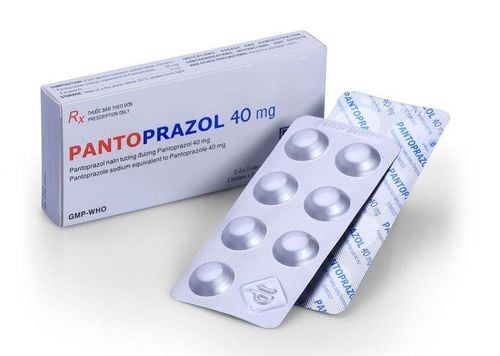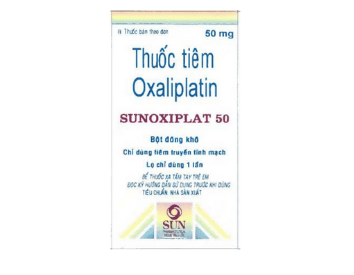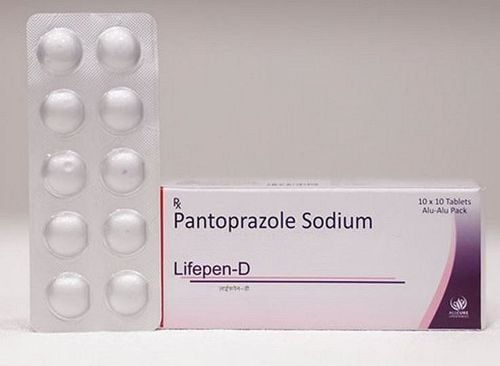This is an automatically translated article.
Oxaliplatin is made in the form of a powder for injection or solution for injection, with the main ingredient being Oxaliplatin. The drug is indicated for use in the treatment of colon and rectal cancer.1. Effects of the drug Oxaliplatin
Oxaliplatin contains the active ingredient Oxaliplatin. Oxaliplatin is an anti-cancer drug containing platinum, belonging to the group of alkylating drugs. Oxaliplatin inhibits the synthesis and transcription of DNA, contributing to slowing down, stopping the growth of cancer cells.Indications for use of Oxaliplatin:
Adjuvant treatment of stage 3 colon cancer: Oxaliplatin in combination with fluorouracil and leucovorin for adjuvant treatment of stage III colon cancer in patients who have undergone radical surgery. Treatment of late-stage colorectal cancer: First-line therapy: Oxaliplatin in combination with fluorouracil and leucovorin for the treatment of patients with advanced colorectal cancer who have not previously been treated or operated on. 2nd therapy: Treatment of recurrent or advanced late colorectal cancer within 6 months of first-line therapy, a combination of fluorouracil, leucovorin, and irinotecan. Contraindications to the use of Oxaliplatin:
People who are sensitive to Oxaliplatin, platinum derivatives or other components of the drug. Women who are pregnant or breast-feeding. People with severe renal failure (Clcr index less than 30ml/min).
2. How to take Oxaliplatin
Oxaliplatin is administered intravenously over 2 hours. It is necessary to dilute the powder form for injection and perform the dilution of the solution product immediately before use.The diluted solution can be stored in the refrigerator for up to 24 hours, at room temperature for about 6 hours. The reconstituted solution will need to be sensory checked prior to injection, and the vial should be discarded if cloudy or discolored.
Direct contact with Oxaliplatin should be avoided during the preparation process. If the Oxaliplatin solution comes into contact with the skin and mucous membranes, it is necessary to wash the skin and mucous membranes with soap and water, wash the mucous membranes by rinsing with plenty of water on top.
3. Dosage of Oxaliplatin
3.1. In adults
Usual dose:Before each cycle of regimen 2 days should use antiemetic drugs of the selective serotoninergic group such as (dolasetron, granisetron, ondansetron), with or without dexamethasone. Oxaliplatin, fluorouracil and leucovorin combination regimen (FOLFOX 4) was used for 2 consecutive days. The 2-day regimen can be repeated after 2 weeks: Day 1: Oxaliplatin 85g/m2, leucovorin 200mg/m2, IV infusion over 2 hours. Then, fluorouracil 400 mg/m2 is injected directly into the vein over 2-4 minutes, followed by an intravenous infusion of fluorouracil 600 mg/m2 over 22 hours. Day 2: Do not use Oxaliplatin. Only leucovorin 200 mg/m2 should be administered intravenously over 2 hours. Then fluorouracil 400mg/m2 is injected directly into the vein over 2-4 minutes, followed by intravenous infusion of fluorouracil 600mg/m2 over 22 hours. Dosage adjuvant treatment of colorectal cancer stage 3 after radical surgery:
Use 12 cycles (for 6 months). In patients treated for late colorectal cancer, this regimen should be used until signs of disease progression or intolerable toxicity develop. Dosage for treatment of late stage colorectal cancer or adjuvant treatment of colorectal cancer:
Alternative regimens such as modified Folox 6 can be used. Modified Folox 6 was also used for 2 consecutive days. Oxaliplatin 85mg/m2 and leucovorin 400mg/m2 (or 350mg/m2) concurrently, intravenously over 2 hours. Then, fluorouracil 400mg/m2 intravenously over 5 minutes; Next, intravenous infusion of fluorouracil 1200mg/m2/day for 2 days; The total dose of fluorouracil is 2800 mg/m2/cycle. Dosage modification to reduce toxicity:
It may be necessary to change the dose or duration of Oxaliplatin infusion to limit some of the drug's side effects such as toxicity on the nervous system, hematopoietic system and gastrointestinal system. Increasing the infusion time of Oxaliplatin from 2 hours to 6 hours can minimize acute toxicity, without the need to adjust the infusion time of fluorouracil and leucovorin.
3.2. In other subjects
Children: Do not give Oxaliplatin to children; Patients with renal impairment: There are no recommendations for dose adjustment of Oxaliplatin in patients with renal impairment. However, patients with renal failure with creatinine clearance less than 30ml/min, AUC increased by 190% should not use the drug; Patients with hepatic impairment : No dose adjustment is required; Elderly: No dose adjustment is required in patients over 65 years of age in combination using Oxaliplatin, fluorouracil and leucovorin for treatment regimens for advanced colorectal cancer. Overdose: When using Oxaliplatin in overdose, the patient has shown to have thrombocytopenia, hypersensitivity reactions, gastrointestinal disorders, bone marrow suppression, neurotoxicity. In case of drug overdose, the patient should be closely monitored for health and treated symptomatically.Missed dose: Oxaliplatin is administered by infusion by healthcare professionals, so there is little or no chance of a missed dose.
4. Oxaliplatin side effects
When using Oxaliplatin, patients may experience some side effects such as:Common: Fever, fatigue, pain, headache, dizziness, insomnia, diarrhea, nausea, vomiting, abdominal pain , constipation, anorexia, taste disturbance, dyspepsia, flatulence, stomatitis, leukopenia, thrombocytopenia, anemia, neutropenia, increased ALT and AST, increased total bilirubin, back pain , cramps, arthralgias, peripheral neuropathy, dyspnea, upper respiratory tract infections, cough, rhinitis, epistaxis, pharyngitis and pharyngo-laryngeal dysesthesia, increased serum creatinine, tear regulation disorders, allergic reactions, injection site reactions, hypersensitivity, hiccups, edema, chest pain, peripheral edema, dehydration, thromboembolism, dysuria, hypokalemia; Uncommon: Acute renal failure, anaphylaxis, anaphylactoid reactions, increased alkaline phosphatase; Rare: Hemolytic anemia, immune-allergic thrombocytopenia, rapid visual impairment, transient vision loss (reversible after drug discontinuation), optic neuritis, colitis , pancreatitis, pulmonary fibrosis, interstitial lung disease, deafness, encephalopathy syndrome,...
5. Be careful when using Oxaliplatin
Before and while using Oxaliplatin, patients should note:Use gloves, masks or goggles when handling Oxaliplatin; Oxaliplatin must be used under the supervision of a specialist or experienced doctor; Oxaliplatin is in the combination regimen with fluorouracil and leucovorin, so it is necessary to consider the relevant information of these two drugs; Treatment with Oxaliplatin is often accompanied by two types of primary peripheral sensory neuropathy. Accordingly, the duration and severity of the disease will increase with dose. Patients should be advised to avoid eating cold foods/drinks, to avoid exposure to cold temperatures and to wear gloves when handling cold objects; When infusing Oxaliplatin, patients should not apply cold to prevent the risk of mucositis; The duration of Oxaliplatin infusion can be extended if the rate of pharyngeal-pharyngeal dysesthesia is to be reduced; Oxaliplatin can cause pulmonary fibrosis. If there are unexplained respiratory manifestations such as dyspnea, dry cough, infiltrates on chest X-ray, the drug should be withheld until the pulmonary fibrosis is eliminated; Before each cycle of treatment with Oxaliplatin, a liver function test should be performed because Oxaliplatin can cause hepatotoxicity; Users of the combination of Oxaliplatin, fluorouracil, and leucovorin are more likely to experience thrombocytopenia and bleeding compared with the combination of fluorouracil and leucovorin alone. Therefore, it is necessary to check the blood count (white blood cell count, platelet count) and blood chemistry (creatinine, bilirubin, ALT, AST) before each treatment cycle; Oxaliplatin should be used with caution in patients with renal failure; In continuous infusion, taxane derivatives (paclitaxel, docetaxel) should be used before platinum derivatives (cisplatin, carboplatin, oxaliplatin) to limit the risk of myelosuppression and increase efficacy; Concomitant use of Oxaliplatin with 5-fluorouracil may increase the risk of liver and gastrointestinal side effects; Elderly patients are often more sensitive to some side effects of Oxaliplatin such as diarrhea, hypokalemia, dehydration, fatigue, syncope, leukopenia; The efficacy and safety of Oxaliplatin has not been evaluated in children; Oxaliplatin is not recommended during pregnancy, if it is mandatory to use it, it should be prescribed by a doctor and with the consent of the patient; Contraindications to the use of Oxaliplatin during lactation, if taking the drug, it is necessary to stop breastfeeding; Side effects such as vision abnormalities, especially transient loss of vision, may affect the patient's ability to drive and use machines. Therefore, patients should be warned about the effect of Oxaliplatin on the ability to drive and use machines.
6. Oxaliplatin drug interactions
Some drug interactions of Oxaliplatin include:Oxaliplatin may increase the concentration/effect of natalizumab and live vaccines; The combination of cytotoxic drugs (including Oxaliplatin) with clozapine should be avoided because of the increased risk of agranulocytosis; Using Oxaliplatin, fluorouracil, leucovorin regimens concurrently with anticoagulants may prolong prothrombin time and INR; Co-administration of Oxaliplatin with capreomycin, aminoglycosides, polymyxins, diuretics may increase the risk of nephrotoxicity and ototoxicity; Trastuzumab may increase the concentration/effect of Oxaliplatin; Echinacea reduces the concentration/effect of Oxaliplatin; Do not use sodium chloride solution or solutions containing chloride to dissolve and dilute Oxaliplatin; Do not use aluminum needles and infusion equipment when using Oxaliplatin because aluminum can destroy platinum derivatives; Do not mix or give other drugs into the same intravenous line with Oxaliplatin. Before infusion of Oxaliplatin or concomitant drugs, the intravenous line should be cleaned with 5% dextrose solution; Oxaliplatin drugs are incompatible with solutions or alkaline drugs such as fluorouracil, so these drugs should not be mixed or given into the same intravenous line of Oxaliplatin; Oxaliplatin concentration 0.5mg/ml combined with diazepam concentration 5mg/ml will create a white precipitate immediately after the combination. Because it is a cancer treatment drug, Oxaliplatin has many side effects. Therefore, during the course of taking the drug, if unusual symptoms or side effects become more severe, the patient should immediately notify the doctor.
Please dial HOTLINE for more information or register for an appointment HERE. Download MyVinmec app to make appointments faster and to manage your bookings easily.













